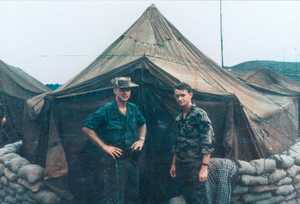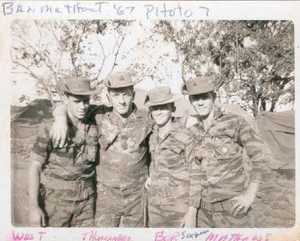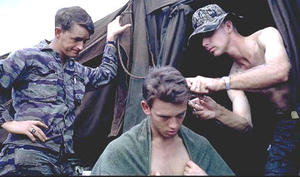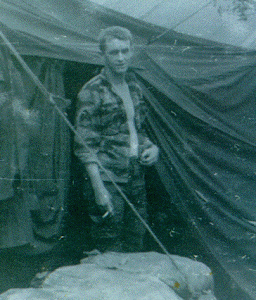Robert “Bob” Eugene Smyers
SFC – U.S. Army
4th Inf Div, 2nd Bde LRRP
16 December 1939 – 13 August 2009
Ohio and Florida
2nd Bde LRRP CO Cpt Garnett Platoon Sergeant Smyers SSGT Popay
Oasis, late 1967

Cpt Garnett and Platoon Sergeant Smyers
 Bob Smyers’ C&C slick for hot extraction November 1967. Cpt. Garnett took picture and almost fell out when chopper
Bob Smyers’ C&C slick for hot extraction November 1967. Cpt. Garnett took picture and almost fell out when chopper
banked hard. Sgt. Popay’s team popped smoke for the pickup slick, and the NVA popped their own red smoke too!
Platoon Sergeant Smyers checking work of barber Cpt Garnett on Gary Crowder

Malan West “T-Bird” Thunander Smyers Matthews
Ban me Thout, 1967
Team Leader “Hotel-2-Alpha” Smyers, “Doc”, “Saul” (KIA), Malan West

Hawthorne, Smyers, Tilley – Oasis 1967
Rodger T Crunk, PATROLLING Fall 2009
Greetings to all my Brothers,
I begin this article with the sad news that Bob Smyers passed away Aug. 13th, 2009, his wife Wanda followed a short time later, Aug. 19th. They were laid to rest together in the Florida National Cemetery in Bushnell, Florida on Aug. 24th. I spoke with his stepson, Mike who reiterated that his Dad was a loving husband and a great Father. He was a good man, a patriot who served his country well.
Bob was a 2nd Brigade LRRP 1967/1968. He served as the Ranger Association Chaplin for several years and was one of our staunchest supporters. He will be missed by those he served with and those of us who came to know him later through the Association. The following is part of an article he wrote for the 4 Div Ranger website. You will be missed Bob. Bob Smyers is a veteran of fourteen years service with the United States Army. He enlisted in 1956. His major assignments included the 3rd Infantry Division in Swienfurt, Germany, the 7th Infantry (Bayonet) Division in Camp Hovey, Korea, and the 4th Infantry Division in the Central Highlands of the Republic of Vietnam.
Upon arrival in Vietnam on April 1, 1967 he was assigned as a rifle squad leader with A Company, 1/22nd Infantry, 4th Infantry Division. Soon after he joined the LRRP unit of the 2nd Brigade on May 14, 1967. He was assigned as team leader, then platoon sergeant until the end of his tour, March 29, 1968. After his tour, he was assigned to Fort Benning, Georgia as First Sergeant to the post replacement company. He was reassigned to the Weapons Committee at the Infantry Training School as an instructor in January 1969. He remained an instructor up to his discharge in March 1970. He left the army having obtained the rank of Sergeant First Class E-7.
Bob’s Notes as an Author:
“The most often asked question I get about the articles I write as well as the stories is; how do you remember so much detail? One answer might be that I have always paid attention to details. However, the events I write about are forever branded into my memory. In these situations I somehow took a mental picture and added a narrative with each one as it happened. I believe experience is everlasting and we choose to remember or block out according to our psychic make up.
Regardless of that, as a LRRP leader I had to make snap decisions that could mean life or death for my team and myself. This not only weighs heavy on a leader’s mind but bores a place of residual residence. At least it did me. Thus making recall relatively easy even after 32 years. Some say I have a photographic memory. I prefer to believe these were significant events in this man’s life that will be there the remainder of my days.”
BOB & WANDA SMYERS
SMYERS, Robert E. 69, died Aug. 13, 2009. Graveside services 11am, Aug. 24, 2009, at Florida National Cemetery. Visitation Sunday, 1-3 pm at Gee & Sorensen Funeral Home.
SMYERS, Wanda 71, died Aug. 19, 2009. Graveside services 11am, Aug. 24, 2009, at Florida National Cemetery. Visitation Sunday, 1-3 pm at Gee & Sorensen Funeral Home.
Burial is at the Veterans Administration Florida National Cemetery, Bushnell, Florida
Ranger Bob Smyers and his lovely Wife, Wanda At Peace Rangers, I am sorry to inform you that Bob and Wanda Smyers passed away in August. Bob died at home August 13th, Wanda in the hospital on August 19th. They had been seriously ill for quite a while and had fought the good fight for many years together. Bob was one of those E/58th LRP/LRRP-types whose Unit became K Co, 75th Ranger after he DEROSed in 1968. Like many of our LRP/LRRPs, Bob was a LRRP at heart, yet carried the Ranger spirit long before he was known as a Ranger after his RVN tour ended. As a K/75th-type myself, Bob was one of those Legends I heard so much about and tried so hard to measure up to in my time in RVN. They obviously set the bar FAR too high for mortals such as me, but their examples sure helped me survive the attempts. Wanda was Bob’s personal Angel, a gal whose health had given her plenty of trouble, but never changed to her sunny disposition or her love for her Family and her Buddy, Bob. Those two were a set wherever they went a pleasure to be around and willing to help in any way possible if there was something in need of attention. They passed away within a week of each other, so I imagine they’re hard at work helping somebody in the next life, but TOGETHER as they were in this one.
Sua Sponte,
Dana McGrath
K/75th
Links to Bob Smyers’ stories:
https://www.4thdivrangers.com/2ndbde/smyers.html
https://www.wgallion.com/vietnam/night.htm
Article 1
How We Operated
LRRP was our first designation. It stood for Long Range Recon Patrol meaning your job was to be just that, reconnaissance. The team was usually made up of a total of four men. However, there have been as little as two men. Only once during my tour with the Lurps did one man get dropped in on his own, and that was John Powers (now deceased after 3 tours in Vietnam). He wanted to do it and Brigade accommodated him. He was to observe and if the opportunity presented itself, to sniper. He was equipped with an M-14 and scope. He was trained as a sniper in Recondo school. This insertion was different from the normal Lurp team. He was dropped in by one chopper without gunship support. He repelled about 75 feet into the jungle below. A normal insertion was done with five Helicopters. One was called command and control ship (C&C). This chopper carried the two pilots, two door gunners, the platoon leader or platoon Sergeant, and at times both. This ship had gone earlier with the teamleader, and one or the other of the platoon commanders, to make an aerial recon of the area of operation (AO). During this time an insertion point was selected within the AO where the team would be dropped in.
Seldom were extraction points selected in the early concept of Lurp operations. Later, as knowledge increased, extractions points were selected. In the early going of the Lurp concept, a lot was put to trial and error. There had been to my knowledge no specialized training outside of what we learned concerning patrolling techniques in basic or advanced infantry training. The advantage went to the ones who had served overseas and other places where the infantry practiced their trade, destroying. Outside of that we learned as we went, and developed training and methods of operation as we experienced the war. Later there would be the selection of extraction point during initial recon of the AO plus coordinated preplan artillery concentrations in the event a team was on the move, which meant most times the enemy were in hot pursuit. When this happens, it is easier to give a preplanned number to be fired versus trying to plot your location on the run. Any teamleader will tell you that is close to, if not impossible. So the sophistication of operating procedures increased the more we ran missions.
We cut our teeth by trial and error. It was not always pretty. The teams not only had to learn but the commanders whom we worked for, to supply them information not otherwise obtainable. Unfamiliar with our size and capability they at times felt we could act and perform as a rifle company. Along with the C&C ship you had two choppers know as slicks. I guess they got the name by the way they would insert or extract us. Slipping across the jungle canopy at top speed and barely above the tree tops so as to maintain stealth. In each slick you have two pilots and two doorgunners, which is standard. The first slick carries the team 2, 4, or 5. Five came later in my tour as the missions changed from just recon (which produced much action due to contact with the enemy) to combat missions with the intent of ambushing targets of opportunity. The second slick was equipped and manned as the first slick minus, a Lurp team. Then you had two gunships equipped with pilots, gunners and rockets. They flew as support and diversion. They also flew at tree top level to the left and right of the insertion slicks. The routine was the C&C ship which had the same staff and pilots, who had made the earlier recon of the AO, were now guiding the ships below from 3,000 feet up. As the Landing Zone (LZ) appeared ahead,they would inform the pilots below, guiding them on course. As the insertion ship got closer, they would begin a count down. I.E., 600, 500,etc., (meters), until set down. They continued this until the insertion slick cleared the tree tops, over the LZ. Once they cleared they would say drop down. The pilots would come as close to the ground as possible and hover. The team was already standing on the chopper skids, ready to jump.
The teamleader was to always go first. Any hesitation by a team member, was overcome by the knowledge that the doorgunner would give you a little help. He had to because this was a very crucial point. The team and the chopper were very vulnerable at this point. One well aimed shot from an enemy rifleman could spell disaster to the chopper and the team. Even though the pilots tried to get as close to the ground as possible, the height could vary according to the undergrowth. You often tasted your boots in your mouth. The insertion is quick and that is how we Lurps liked it. Too much activity may draw attention. While this is going on the gunships are circling the LZ and surrounding area as a cover and diversion. The second slick follows along behind the fist slick in the event we are dropped in a hot LZ. If this happens the gunships take the enemy under fire while the second slick comes in for the team. This happened to my team once. We were immediately snatched up and to my surprise we were flown a little farther and again inserted. I cannot say I liked this idea at first, but I learned quickly it was the right thing to do. If I and the team members had time to consider what had happened we probably would not have been able to go in again. If I recall it was Charles Mathews, Doc, and Moui. Later as Platoon Sergeant, I saw the results of pulling a team and terminating the mission. One of the best and most courageous of my teamleaders lost it on the next mission he was inserted on. He froze up once he hit the ground. Early extraction was necessary. Once the team is on the ground they move to cover, organize, and let the pilots know, they are okay, so as to get them out of the area. After listening for a short while, the team then moves out of the area, in the event they may have been compromised. They then set out to perform their mission. Recon, combat, or a combination of the two. Missions are normally set for five days.
Lurps are inserted deep in enemy territory. Often requiring radio relay stations. Be it from mountain top to mountain via relay teams or forward air coordinators (FAC), back to Brigade or Battalion command centers. Depending on who they are working for directly. Lurps were made up of all volunteers due to the danger of the job. The life expectancy was short. The men that made up the Lurps were a special breed, much like the Special Forces or Rangers. We often assisted the SOG units (Special Operations Groups), performing missions in Ban Me Thout. Then eventually Ranger units were employed as LRP units and we merged with the 75th Ranger Regiment. Lurps, as the Special Forces and the Army Ranger are an elite group and were ready to accept the challenge that often puts then in harms way. Each named group has paid the price for the privilege of being different. Hopefully this has shed light on what it is to be or have been a Lurp. But once a Lurp. Always a Lurp! Their trademark was tiger fatigues, Australian bush hat, short black automatic weapon called the CAR-15, and known to ambush enemy units of considerable size. It was not so much duty, honor, and country. Although that was forever a part of their makeup. They were men who preferred to be different that loved to live on the edge. They played, fought and some died, for what they believed: all people deserve to chose their own pursuit of happiness. This is not all there is to tell, but it is my best recollection after 32 years. Any Lurp out there should add to this article, as they see fit. Let this be known as article one. Hopefully, others will follow, as this was and is a proud group of men.
Our support now goes to those serving as Long Range Patrol Rangers, of the United States Army. You have a legacy behind you. Pathfinders if you will.
This article is authored by SFC Bob Smyers, PSG. of the 2nd Brigade LRP, 4th Infantry Division. It is dedicated to the Lurps still on patrol (i,e, ,those that have not returned, but forever remain on patrol, in a realm we do not yet understand). May God Bless all.
Bob Smyers
LRRP, 2nd Brigade, 4th Infantry Division





